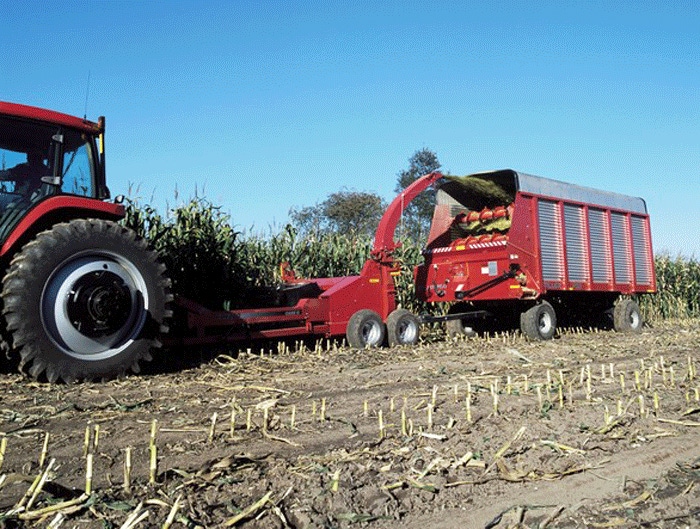
• Proper moisture at harvest is critical and there is a wide variation in the actual moisture of the crop based simply on the milk layer.• Recommendations for length of cut for silage vary depending on crop condition.• At lower whole plant moistures, crop maturity may affect silage quality. Fiber and starch digestion decreases as corn dries down.
August 5, 2011

Agronomists note that a rough estimate of the proper silage harvest period is somewhere between 35 and 45 days after tassel emergence.
In many areas of south-central Pennsylvania, tasseling began close to July 11 on the earliest planted corn. This would indicate that silage harvest should begin close to the 3rd week of August, but in many drought areas silage harvest has begun already.
No one can accurately predict the exact date based on tasseling due to many factors including weather conditions, hybrid characteristics and storage structure type.
Harvest moisture timing
Depending on storage structure type, corn silage is harvested when whole plant dry matter reaches 30 to 35 percent. Optimum dry matter content for bunker silos is 33 to 35 percent; ag bags — 33 to 37 percent, conventional upright silos — 35 to 38 percent and oxygen-limiting silos — 40 to 45 percent dry matter.
Proper moisture at harvest is critical and there is a wide variation in the actual moisture of the crop based simply on the milk layer.
The most accurate measurement of whole plant moisture is to conduct moisture testing. Begin by taking a few plants from selected fields at dent stage. Run these plants through some type of chopper or lawn mower and thoroughly mix together.
Use a Koster tester or a microwave to determine whole plant moisture.
This moisture can then be used to predict harvest date. The expected dry down rate for corn silage is 0.5 to 0.6 percent per day. For example, if your crop moisture levels test at 70 percent and your target harvest moisture is 65 percent you need an additional dry down of 5 percent.
Expected harvest time
Dividing by the dry down rate of 0.5 to 0.6 percent per day indicates that you can expect to be harvesting in 8 to 10 days. Be sure to test the actual moisture content again at and during harvest.
When moisture drops below 60 percent the rate of dry down increases beyond 0.5 percent per day and the crop will become too dry for optimum fermentation.
Length of cut
Recommendations for length of cut for silage vary depending on crop condition.
Drier crops should be cut finer to produce smaller particles that minimize air pockets. Use of highly digestible hybrids, such as BMR corns, requires a slightly longer cut to maintain effective fiber.
A general recommendation for corn being chopped for silage without processing is a 3/8 inch theoretical length of cut (TLC), but more mature crops may require a shorter length.
For processed corn silage the recommended chop length is ¾ inch TLC. Some farms rely on their nutritionists to fine tune the chop length based on farm specific conditions.
Processing silage
At lower whole plant moistures, crop maturity may affect silage quality. Fiber and starch digestion decreases as corn dries down.
Processing at harvest may be needed to maximize digestion on more mature crops.
The goal of processing is to ensure breakage of all kernels and cobs to assist digestion. Processing also can affect fiber length so choppers equipped with a processor typically lengthen their cut to ¾ inch.
Recommended processor settings for corn silage are 1 to 3 mm (about the width of a dime) depending on the TLC and the moisture of the crop. Drier corn requires more aggressive processing (i.e. 1 – 2 mm).
Rate of filling
Once you start filling a silo or ag bag you want to get the task completed as rapidly as possible. Until the silo or pile is sealed from exposure to air, the fresh forage will continue to respire and lose dry matter and increase in temperature.
However, when filling a bunker or a trench too fast, filling can lead to situations where the packing equipment cannot keep up with delivery, especially with high capacity choppers.
A general rule to follow is to have 800 pounds of packing equipment for every ton of corn silage that is delivered to the bunk per hour.
For example: at a chopping rate of 125 tons per hour you would need 800 x 125 = 100,000 pounds or 50 tons of packing equipment.
Experienced packers recommend increasing tire inflation pressures on packing equipment to improve packing results. Keep packing layers to 6 inches for best results.
Get equipment ready now
First, make sure all harvesting equipment and storage facilities are ready to go. Clean out all old silage before adding this year’s crop. Check all silo walls/surfaces for cracks or holes.
Check surface water drains to make sure they are opened to allow effluent to move away from silage.
On upright silos, check door seals, ladders and safety cages. Lubricate and adjust unloaders and make certain support cables are strong.
Engineers note that any silo older than 10 years should be checked for structural integrity. A quick inspection may save lives and thousands of dollars in lost feed and damaged property.
Harvesting equipment should also be serviced at this time. The last thing a silage producer wants is a delay in harvest due to equipment failure.
Check filters, hoses, fittings, belts, chains, bushings, sprockets and order replacement or spare parts. Sharpen knives and cutter bars and check the accuracy of cutter head adjustments.
Safety concerns
Silage harvest is always a busy season that involves the operation of large equipment in fields and on highways for long hours.
Be certain you have reviewed all safety procedures with your operators and that all safety devices on equipment are maintained and in working condition.
Ensure that family and employees understand your expectations to keep safety first!
You May Also Like



